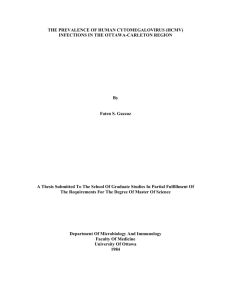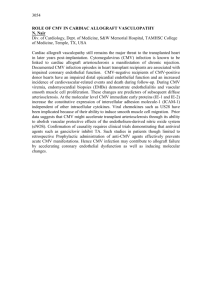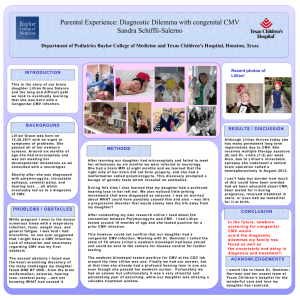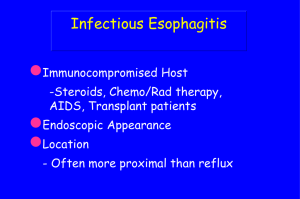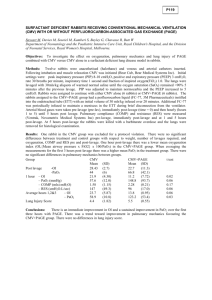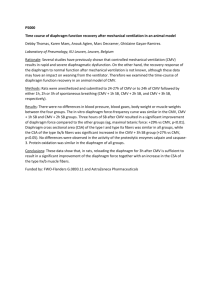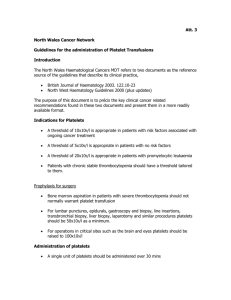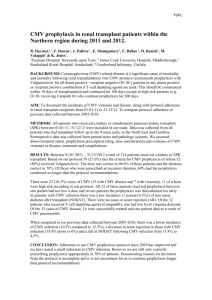Cytomegalovirus esophagitis in an immunocompetent patient: Case
advertisement
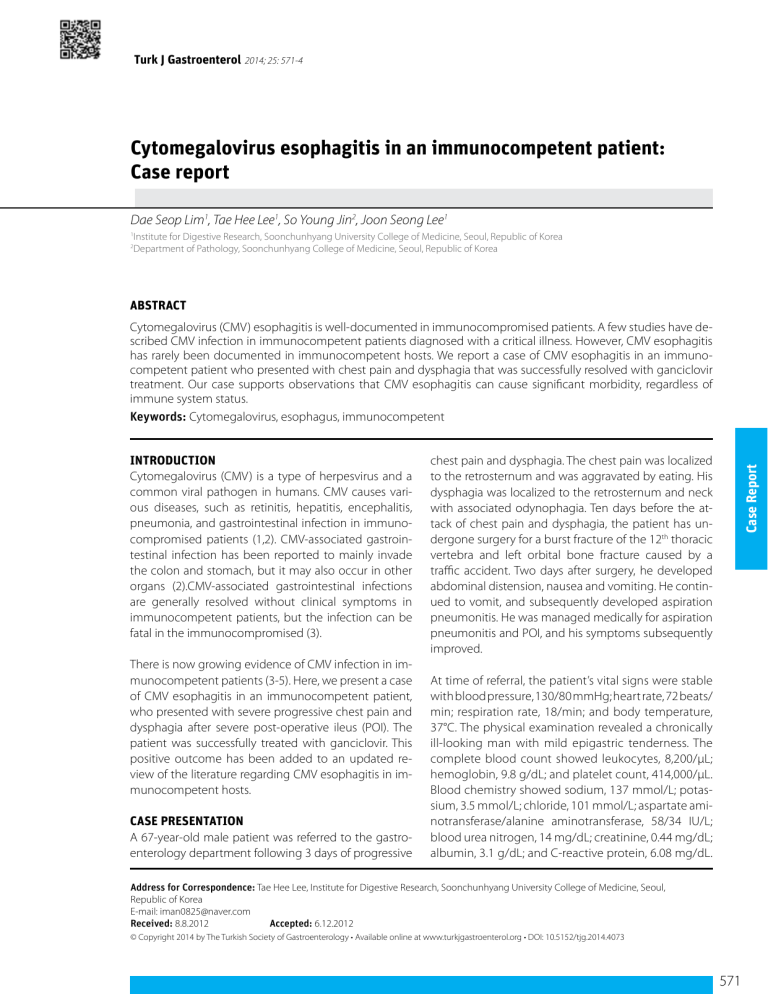
Turk J Gastroenterol 2014; 25: 571-4 Cytomegalovirus esophagitis in an immunocompetent patient: Case report Dae Seop Lim1, Tae Hee Lee1, So Young Jin2, Joon Seong Lee1 Institute for Digestive Research, Soonchunhyang University College of Medicine, Seoul, Republic of Korea Department of Pathology, Soonchunhyang College of Medicine, Seoul, Republic of Korea 1 2 ABSTRACT Cytomegalovirus (CMV) esophagitis is well-documented in immunocompromised patients. A few studies have described CMV infection in immunocompetent patients diagnosed with a critical illness. However, CMV esophagitis has rarely been documented in immunocompetent hosts. We report a case of CMV esophagitis in an immunocompetent patient who presented with chest pain and dysphagia that was successfully resolved with ganciclovir treatment. Our case supports observations that CMV esophagitis can cause significant morbidity, regardless of immune system status. Keywords: Cytomegalovirus, esophagus, immunocompetent There is now growing evidence of CMV infection in immunocompetent patients (3-5). Here, we present a case of CMV esophagitis in an immunocompetent patient, who presented with severe progressive chest pain and dysphagia after severe post-operative ileus (POI). The patient was successfully treated with ganciclovir. This positive outcome has been added to an updated review of the literature regarding CMV esophagitis in immunocompetent hosts. CASE PRESENTATION A 67-year-old male patient was referred to the gastroenterology department following 3 days of progressive chest pain and dysphagia. The chest pain was localized to the retrosternum and was aggravated by eating. His dysphagia was localized to the retrosternum and neck with associated odynophagia. Ten days before the attack of chest pain and dysphagia, the patient has undergone surgery for a burst fracture of the 12th thoracic vertebra and left orbital bone fracture caused by a traffic accident. Two days after surgery, he developed abdominal distension, nausea and vomiting. He continued to vomit, and subsequently developed aspiration pneumonitis. He was managed medically for aspiration pneumonitis and POI, and his symptoms subsequently improved. Case Report INTRODUCTION Cytomegalovirus (CMV) is a type of herpesvirus and a common viral pathogen in humans. CMV causes various diseases, such as retinitis, hepatitis, encephalitis, pneumonia, and gastrointestinal infection in immunocompromised patients (1,2). CMV-associated gastrointestinal infection has been reported to mainly invade the colon and stomach, but it may also occur in other organs (2).CMV-associated gastrointestinal infections are generally resolved without clinical symptoms in immunocompetent patients, but the infection can be fatal in the immunocompromised (3). At time of referral, the patient’s vital signs were stable with blood pressure, 130/80 mmHg; heart rate, 72 beats/ min; respiration rate, 18/min; and body temperature, 37°C. The physical examination revealed a chronically ill-looking man with mild epigastric tenderness. The complete blood count showed leukocytes, 8,200/μL; hemoglobin, 9.8 g/dL; and platelet count, 414,000/μL. Blood chemistry showed sodium, 137 mmol/L; potassium, 3.5 mmol/L; chloride, 101 mmol/L; aspartate aminotransferase/alanine aminotransferase, 58/34 IU/L; blood urea nitrogen, 14 mg/dL; creatinine, 0.44 mg/dL; albumin, 3.1 g/dL; and C-reactive protein, 6.08 mg/dL. Address for Correspondence: Tae Hee Lee, Institute for Digestive Research, Soonchunhyang University College of Medicine, Seoul, Republic of Korea E-mail: iman0825@naver.com Received: 8.8.2012 Accepted: 6.12.2012 © Copyright 2014 by The Turkish Society of Gastroenterology • Available online at www.turkjgastroenterol.org • DOI: 10.5152/tjg.2014.4073 571 Lim et al. CMV esophagitis in an immunocompetent patient The patient was negative for HBs antigen, anti-HCV antibody, and anti-HIV antibody. The patient had taken medications to treat hypertension, diabetes mellitus, and chronic obstructive pulmonary disease for two years. He declined a blood transfusion and immunosuppressant drugs, such as glucocorticoids. Case Report Upon referral, the patient underwent esophagogastroduodenoscopy (EGD), which revealed a patch distribution of superficial ulcers on the larynx, the upper and the mid esophagus (Figure 1a). In addition, confluent superficial ulcers were observed in the lower esophagus (Figure 1b). Based on the patient’s recent history of vomiting associated with POI, secondary reflux esophagitis was initially considered in the differential diagnosis. However, the presence of a systemic esophagitis disease such as CMV esophagitis could not be excluded with certainty due to the presence of multiple discrete ulcers on the larynx. Thus, we performed a biopsy of the lower esophagus and performed polymerase chain reaction (PCR) for the presence of CMV in the tissue. Serum culture of CMV, antibody tests for CMV IgM and IgG, real-time PCR for CMV, and an antigenemia test for CMV were also conducted. Pathological examination of the esophageal biopsy specimens showed an ulcerated esophageal mucosa with acute inflammation and intranuclear and intracytoplasmic inclusion bodies (Figure 2a). Immunostaining using a specific antiCMV antibody was positive (Figure 2b), as was CMV PCR of the esophageal tissue. Serologic tests showed that the patient was positive for CMV IgG, negative for CMV IgM, and negative for CMV antigenemia. a b Figure 1. a, b. Endoscopic findings in the patient. Multiple discrete ulcers with sharp margins in the larynx are noted (a). Geographic ulcers on the lower esophagus are observed (b). a Initial therapy began with administration of a proton-pump inhibitor. However, chest pain and dysphagia did not improve after 7 days of therapy. Therefore, ganciclovir (5 mg/kg) was administered intravenously at 12-h intervals for 14 days. This treatment was well-tolerated and the symptoms completely resolved. A follow-up EGD revealed healing of the superficial ulcers on the larynx (Figure 3a) and the esophagus (Figure 3b). The informed consent was taken from patient for this case presentation. DISCUSSION There have been few studies describing CMV infection in immunocompetent patients (3-5), which is generally asymptomatic or may present as a form of mononucleosis syndrome. However, CMV infection is associated with prolonged hospitalization or death in immunocompetent patients with critical illnesses. To-date, organ-specific complications have been described in immunocompetent hosts. Gastrointestinal involvement with CMV infection is uncommon in immunocompetent hosts, with cases primarily limited to reports of CMV colitis (6). In contrast, little is known about CMV esophagitis in immunocompetent patients. A PubMed search (www.ncbi.nlm.nih.gov/PubMed) and KoreaMed search (http://www.koreamed.org/SearchBasic.php) using a combination of terms including ‘cytomegalovirus/CMV’, ‘esophagitis/esophageal ulcer’ and ‘immunocompetence/immunocompetent’ yielded nine articles (7-15). Table 1 summarizes the clinical features of these nine cases of CMV esophagitis in immunocompetent patients and includes data from our current patient, bringing the total to 10 reported cases. CMV esophagitis in immunocompetent hosts occurs more frequently in males, with a median age of 56.8 years. Advancing age is potential risk factor for CMV esophagitis in immunocompetent hosts, which is likely a reflection of a weakened immune system as a consequence of aging (16). There are extensive studies demonstrating that aging is associated with a decline in cellular and humoral immunity.Age-related dysfunctions of B and T cell lymphocytes, and age-related impairments in the regulation of the immune response by cytokines and other factors, and perturbation of mucosal immunity are thought to contribute to a relative immunodeficiency in the elderly. Co- b Figure 2 a, b. Pathologic findings in the patient. Enlarged cytomegalovirus (CMV)-infected cells with intranuclear and intracytoplasmic inclusion bodies in the esophageal mucosa are shown by hematoxylin & eosin staining (×400) (a). Positive immunohistochemical stain for CMV (×400) is noted (b). 572 Turk J Gastroenterol 2014; 25: 571-4 a b Figure 3. a, b. Endoscopic findings after ganciclovir therapy. Multiple laryngeal ulcers are completely healed (a). Geographic esophageal ulcers are improved (b). Lim et al. CMV esophagitis in an immunocompetent patient Table 1. Summary of CMV esophagitis cases involving immunocompetent patients Characteristics Median age (range) Male (%) Number of patients (n=10) 56.8 years (32-77) 7 (70%) Presenting symptoms (%) Bleeding 5 (50%) Epigastric pain 5 (50%) Dysphagia (including odynophagia or chest pain) 4 (40%) Fever 3 (30%) Co-infected sites (%) Stomach 1 Duodenum 1 Colon 1 Larynx 1 Endoscopic findings (%) Deep ulcers 3 (30%) Superficial ulcers 4 (40%) Erosions 3 (30%) CMV inclusions (%) 9 (90%) Immunohistochemical stain (%) Positive 5 (50%) Not available 5 (50%) CMV IgG (%) 6 (60%) CMV IgM (%) 3 (30%) CMV antigenemia 0 Treatment Supportive care 2 (20%) Ganciclovir 8 (80%) Outcome Recovery 9 (90%) Death 1* (10%) CMV: Cytomegalovirus *The patient died due to progressive pancreatitis and not CMV infection. morbid diseases are also more common in geriatric patients that in younger patients. Reactivation has been presumed to be a consequence of the severity of immune system compromise during critical illness, the intrinsic viral load, and perhaps the severity of the reactivation stimulus (17). Thus, critical illness is another potential risk factor of CMV esophagitis in immunocompetent patients. Our review of the literature found seven patients with critical illnesses, including brain hemorrhage, abdominal surgery and infections, and pulmonary infections. Two patients were alcoholics, and only one had no medical problems before the CMV esophagitis diagnosis. The role of CMV infection in immunocompetent patients with critical illness has been investigated previously (5). Although these studies used various virologic and statistical methods and designs, most demonstrated that CMV infection is common in critically ill patients and is associated with one or more adverse clinical outcomes (5). In our review of the literature, the common symptoms of CMV esophagitis were bleeding, epigastric pain and dysphagia. Although previous reports suggested that gastrointestinal hemorrhage caused by CMV esophagitis is rare, bleeding was a common symptom of CMV esophagitis in immunocompetent patients in our case review (18). Co-infection of other organs, including the larynx, stomach, duodenum, and colon, was observed in almost half of the reported patients. Endoscopic findings of CMV esophagitis in immunocompetent patients include deep ulcers, superficial ulcers and erosions. EGD revealed a variety of findings, such as mucosal ulcerations, erosions, hemorrhage and nodules, in CMV esophagitis of immunocompromised patients. In transplant cases, erosions or ulcers progress and fuse together, thereby forming a giant or geographic ulcer (19). Because the endoscopic appearance is nonspecific, the diagnosis rests on the histopathologic identification of viral-infected cells in biopsy tissues, occasionally supplemented by ancillary techniques such as immunohistochemistry or in situ hybridization (20). Case Report Turk J Gastroenterol 2014; 25: 571-4 Ganciclovir was required for treatment in 80% of immunocompetent patients with CMV esophagitis, with the minority of patients managed conservatively. In our case, the patient did not response to proton-pump inhibitor treatment, and symptoms eventually resolved only after ganciclovir treatment. To-date, CMV treatment has not been established in immunocompetent patients, although it is well-established in the immunocompromised. Since the majority of immunocompetent patients with CMV disease recover without intervention, it is difficult to determine whether or not antiviral therapy has a significant impact on clinical outcome. In conclusion, we have described our observations of one immunocompetent patient with CMV esophagitis and have reviewed nine previously reported cases. This information indicates that CMV esophagitis can cause significant morbidity, even in immunocompetent patients, and support conducting large studies to determine the clinical usefulness of ganciclovir treatment. Ethics Committee Approval: N/A. Informed Consent: Written informed consent was obtained from a patient who participated in this case. Peer-review: Externally peer-reviewed. Author contributions: Concept - T.H.L.; Design - T.H.L.; Supervision J.S.L.; Resource - S.Y.J.; Materials - S.Y.J.; Data Collection&/or Process- 573 Lim et al. CMV esophagitis in an immunocompetent patient ing - D.S.L.; Analysis&/or Interpretation - D.S.L.; Literature Search - T.H.L., D.S.L..; Writing - D.S.L.; Critical Reviews - J.S.L. Conflict of Interest: No conflict of interest was declared by the authors. Financial Disclosure: The authors declared that this study has received financial from Soonchunhyang University Research Fund. REFERENCES 1. 2. 3. 4. 5. 6. Case Report 7. 8. 9. 574 Goodgame RW. Gastrointestinal cytomegalovirus disease. Ann Intern Med 1993; 119: 924-35. [CrossRef ] Hinnant KL, Rotterdam HZ, Bell ET, Tapper ML. Cytomegalovirus infection of the alimentary tract: A clinicopathological correlation. Am J Gastroenterol 1986; 81: 944-50. Wreghitt TG, Teare EL, Sule O, Devi R, Rice P. Cytomegalovirus infection in immunocompetent patients. Clin Infect Dis 2003; 37: 1603-6. [CrossRef ] Rafailidis PI, Mourtzoukou EG, Varbobitis IC, Falagas ME. Severe cytomegalovirus infection in apparently immunocompetent patients: a systematic review. Virol J 2008; 5: 47. [CrossRef ] Limaye AP, Kirby KA, Rubenfeld GD, et al. Cytomegalovirus reactivation in critically ill immunocompetent patients. JAMA 2008; 300: 413-22. [CrossRef ] Klauber E, Briski LE, Khatib R. Cytomegalovirus colitis in the immunocompetent host: An overview. Scand J Infect Dis 1998; 30: 559-64. [CrossRef ] Lee KH, Jang BI, Kim KO, et al. A case of cytomegalovirus esophagitis associated with upper gastrointestinal bleeding. Korean J Med 2009; 76: 40-3. Choi KY, Cho KB, Hwang JY, et al. A case of CMV infection associated with simultaneous esophageal and colonic ulcers. Korean J Gastrointest Endosc 2003; 26: 26-30. Lee SY, Kim YS, Lee JH, et al. A case of cytomegalovirus-associated esophageal and duodenal ulcers in a critically ill immunocompetent patient. Korean J Gastrointest Endosc 2009; 39: 217-21. Turk J Gastroenterol 2014; 25: 571-4 10. Villar LA, Massanari RM, Mitros FA. Cytomegalovirus infection with acute erosive esophagitis. Am J Med 1984; 76: 924-8. [CrossRef ] 11. Venkataramani A, Schlueter AJ, Spech TJ, Greenberg E. Cytomegalovirus esophagitis in an immunocompetent host. Gastrointest Endosc 1994; 40: 392-3. [CrossRef ] 12. Altman C, Bedossa P, Dussaix E, Buffet C. Cytomegalovirus infection of esophagus in immunocompetent adult. Dig Dis Sci 1995; 40: 606-8. [CrossRef ] 13. Weile J, Streeck B, Muck J, et al. Severe cytomegalovirus-associated esophagitis in an immunocompetent patient after short-term steroid therapy. J Clin Microbiol 2009; 47: 3031-3. [CrossRef ] 14. Yagain K, Rao L, Pai K, Pai G. Cytomegalovirus esophagitis in nonimmunocompromised patient--presenting as an acute necrotic (black) esophagitis. Indian J Pathol Microbiol 2011; 54: 852-3. 15. Smith Jr HW, Dressler DD. CMV esophagitis in an immunocompetent host. 2004. (cited: August 2, 2012) Available at: http://www.hospitalmedicine.org/AM/Template.cfm?Section=Home&Template=/ CM/ContentDisplay.cfm&ContentFileID=1590. 16. Schmucker DL1, Heyworth MF, Owen RL, Daniels CK. Impact of aging on gastrointestinal mucosal immunity. Dig Dis Sci 1996; 41: 1183-93. [CrossRef ] 17. Cook CH. Cytomegalovirus reactivation in “immunocompetent” patients: A call for scientific prophylaxis. J Infect Dis 2007; 196: 1273-5. [CrossRef ] 18. Mayeux GP, Smith JW. Massive esophageal bleeding from cytomegalovirus esophagitis. Am J Gastroenterol 1990; 85: 626. 19. Mayoral JL, Loeffler CM, Fasola CG, et al. Diagnosis and treatment of cytomegalovirus disease in transplant patients based on gastrointestinal tract manifestations. Arch Surg 1991; 126: 202-6.[CrossRef ] 20. Schwartz DA, Wilcox CM. Atypical cytomegalovirus inclusions in gastrointestinal biopsy specimens from patients with the acquired immunodeficiency syndrome: diagnostic role of in situ nucleic acid hybridization. Hum Pathol 1992; 23: 1019-26. [CrossRef]
